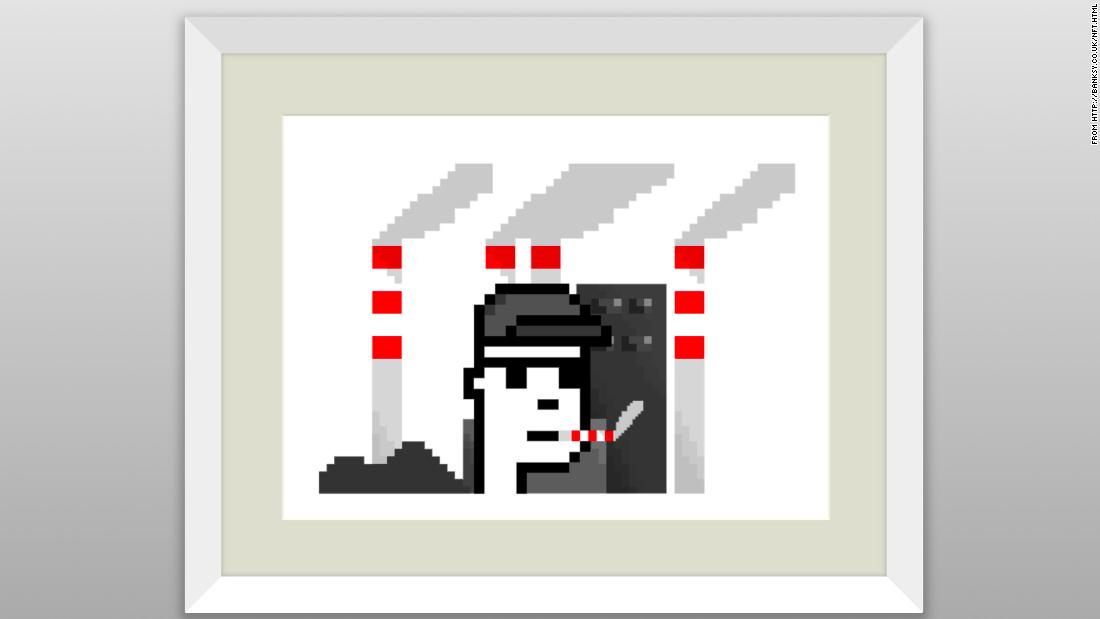Written by Oscar Holland, CNNMegan C. Hills, CNN
An art collector says he paid more than $ 335,000 for a “fake” Banksy, only to have the money returned to him by the suspected con artist.
The sale came after the graffiti artist’s homepage briefly directed users to an online auction offering what appeared to be his very first NFT, or non-fungible token.
The since-deleted page, which appeared on Banksy’s official website on Tuesday, showed a pixelated image of a character smoking sunglasses and a hat. It is linked to an auction hosted by the online marketplace OpenSea, where the work (pictured above) was listed as “Great Redistribution of Climate Change Catastrophe” by a user called gaakmann – a reference to a nickname previously used by the anonymous artist.
Believing he is a genuine Banksy, a UK based collector – who trades digital collectibles under the username Pranksy and describes himself as a ‘big fan’ of the street artist – offered the equivalent of over $ 335,500 in Ethereum cryptocurrency. But when his bid was immediately accepted, ending the auction days earlier than expected, he became “99% sure” that he had been the victim of fraud.
“As soon as (the offer) was accepted I felt it was fake / hacked,” the collector said via email.
How much has the internet changed art?
But in a seemingly bizarre twist, the seller then returned all the money, minus the transaction fees, shortly after the sale. Records stored on Ethereum’s blockchain, a digital ledger of all transactions involving cryptocurrency, appear to support the collector’s version of events.
The collector, who suggested Banksy’s website was hacked, said on Twitter that the scam may have been the work of an “ethical hacker proving a point.”
“Perhaps (the seller was) scared of the media coverage the hack received,” he later told CNN. “I’m really not sure, but very grateful that I got the majority of my Ethereum back.”
Representatives for Banksy did not explain how the image or hyperlink appeared on its official website and did not respond to CNN’s request for comment. A spokesperson for the graffiti artist told the BBC that “the Banksy NFT auctions are not affiliated with the artist in any form.”
Some social media users have since accused the collector of orchestrating the incident for publicity purposes, although he said he had “no desire or need to do a stunt like this for cover. “.
“I aspire to be able to work with artists like Banksy in the future and (to help them) learn more about NFTs,” he added. “Hacking their website and buying an NFT myself wouldn’t be the best way to do it!”
Banksy recently produced a series of works of art in British seaside towns. Credit: Justin Tallis / AFP / Getty Images
NFTs have exploded in recent months, providing a way for collectors to “own” and sell digital assets as if they were physical goods. Renowned artists such as Damien Hirst, Daniel Arsham and John Gerrard have started creating and selling works via NFTs, with major auction houses like Sotheby’s and Christie’s now dedicating multi-million dollar sales to tokens. .
OpenSea currently lists hundreds of NFTs depicting or resembling works by Banksy, although the elusive artist has never suggested he would sell digital art. The platform did not respond to CNN’s request for comment on the incident or whether it was considering reimbursing the deceived collector’s transaction fees.
Although he almost lost hundreds of thousands of dollars, the collector defended OpenSea and said he should have waited for Banksy’s “official verification” before bidding. “I hope to own some of his real work one day,” he added.

